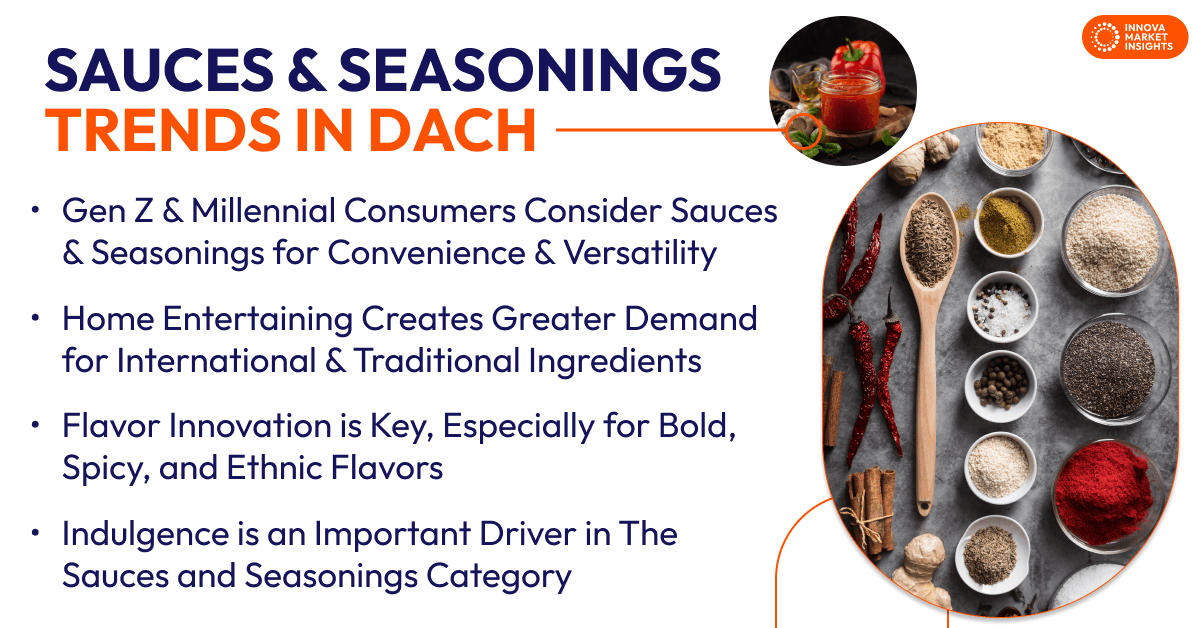October 8, 2025 – This report covers trends in sauces and seasonings in the DACH region, which encompasses Germany, Austria and Switzerland.
Defining Sauces and Seasonings
Sauces encompass a wide range of products, from cooking and pasta products to table sauces. Cooking sauces can be wet or dry sauces, marinades, cooking wine, grilling sauces, and sauces made from a base of tomato, coconut, cream, or vegetables. Pasta and noodle sauces can have a base of cream, tomato, or herb. They can be Italian or Asian and are typically seasoned with herbs, spices, and/or cheese. Table sauces include most condiments, along with salsas, hot sauces, dipping sauces, and ethnic sauces added at the table. Product examples include Tabasco and Worcestershire sauce. Dipping sauces are included under table sauces. Ketchup includes ketchup and tomato-based condiments. Mustards used as condiments fall under sauces and seasonings. Pickles, relish, olives, and pickled peppers are considered pickled condiments and chutney as part of sauces and seasonings. Mayonnaise can be unflavored, flavored, dry, or prepared as a dressing. Wet and dry dressings include common types of products to dress salads. Vinegars can be flavored or unflavored and have uses as condiments, garnishes, reductions, and glazes. Concentrated, cubed, or granular stocks, bouillons, and soup bases are types of stocks, as is gravy. Oils are flavored or unflavored. Seasonings incorporate a broad range of flavoring ingredients, including salts, peppers, herbs, spices, seasoning blends, seasoned breadcrumbs, garlic, sauce mixes, pastes, and citrus juices.
Maturity Plus Innovation
The sauces and seasonings market in the DACH region is mature because these items are everyday household staples. However, brands still can innovate in this category because consumer tastes and interests evolve. The DACH region over-indexes in stocks and seasonings purchases and under-indexes in sauce purchases. When asked in consumer trends research, DACH consumers report purchasing sauces and seasonings for taste and for convenience.
Real, Natural, and Organic
DACH consumers recognize the health angle in sauces and seasonings, especially those that are real and natural. DACH new product launches in sauces and seasonings also stand out for use of organic positioning. In consumer trends research conducted by Innova Market Insights, consumers who were asked about which claims influence their sauce and seasoning purchases named “made with real/natural ingredients” as their number one response. Sauce and seasoning launches monitored by Innova show a strong presence for clean-label flavors, clean formulations, and organic positioning. In fact, the proportion of organic sauces and seasonings in DACH countries far exceeds the proportion globally. Health is a major driver of organic food, and consumers perceive that organically farmed foods are healthy.
Sauces and seasonings that are real and natural can be perceived by DACH consumers as healthy. Today, ultra-processed foods (UPFs) are under fire, so consumers are searching for less processed products and are moving toward home cooking from scratch.
Still, a low proportion of sauce and seasoning launches carry a health claim. Apart from natural and organic, other functional claims are not used very often. No added sugar is one of the most common claims. However, consumers may be associating this claim with natural positioning rather than with better health.

Generation Z Lags Behind, Offers Opportunities
Compared to older generations, sauces and seasoning trends reveal that Gen Z consumers purchase fewer sauces and seasonings. This could be because they don’t cook as often and are less confident about their cooking skills. Marketing opportunities to Gen Z include sauces and seasonings that are convenient to use and offer exciting and unique taste experiences, such as extra hot flavors.
Gen Z consumers especially under-index in purchases of sauces, seasonings, and stocks for scratch cooking. When asked about their sauce and seasoning purchases, Gen Z under-indexes compared to older consumers, particularly for scratch cooking products such as stocks and seasonings. Millennials also buy less often in these areas. Purchase rates are closer to the average in cooking sauces, however, suggesting younger consumers are more likely to value convenience and also versatility when cooking and buying sauces and seasonings.
Home Entertaining Opens the Door for Sauces and Seasonings
Since the pandemic, consumer trends research shows that consumers are socializing and dining more at home. They are also becoming more creative in their home cooking. This presents greater opportunities for variety in sauces and seasonings that expands meal and menu options and enhance menu diversity for home cooks. Many home cooks in the DACH region are preparing more international and ethnic meals, as well as continuing to make traditional meals using local ingredients. Sauces and seasonings also can offer convenience, and they can be made more versatile to meet specific cooking needs. For example, sauces and seasonings can be tailored for the air-fryer or use in stir-frying, as sauces and seasoning trends highlight growing demand for multifunctional and easy-to-use options.
In consumer trends research, consumers say that food cooked at home is healthy and supports healthy eating. In fact, consumers, including those in the DACH region, name cooking from scratch as one of the top ways to eat healthily. They want sauces and seasonings that are real, natural, or organic and also have a short ingredient list with recognizable ingredients. Sauces and seasonings are essential for preparing foods at home and can enjoy the health profile that is associated with home cooking.
Flavor Matters in Sauces and Seasonings
Sauces and seasonings impart flavor, and they are all about flavor. Flavor offerings include hot and spicy, ethnic, exciting flavor options in familiar products, limited editions, seasonal seasonings and sauces, and experimental flavors. Sauces and seasoning trends show that about half of German consumers want spicy, strong, and bold flavors in sauces and seasonings. The growth rate of sauces and seasonings with hot and spicy flavors has accelerated in recent years. Some of this innovation adds a new flavor feature to a familiar product, such as spiciness to mayonnaise.
In/out flavors introduced in limited-edition and seasonal launches can excite consumers about trying new and unfamiliar flavors. In/out flavors are a niche feature that is growing because brands can assess consumer acceptance of new flavors.
Indulgence in Sauces and Seasonings
Sauces and seasonings can be indulgent, and they can add indulgence. Compared to other participants in consumer trends research, German consumers are more likely to prioritize indulgence in food and beverage products. This desire for indulgence applies to sauces and seasoning, suggesting that this category needs to offer excitement, premium experiences, and quality products.
This article is based on Innova’s Sauces & Seasonings in DACH report. This report is available to purchase or with an Innova Reports subscription. Reach out to find out more
